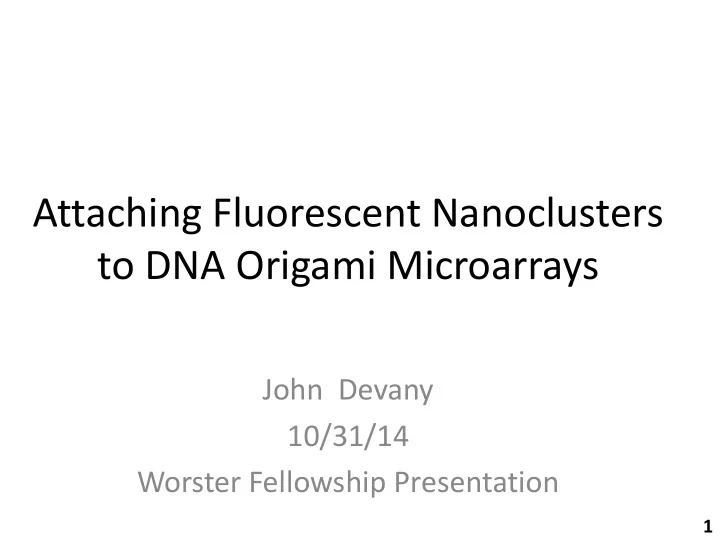

Attaching Fluorescent Nanoclusters to DNA Origami Microarrays John Devany 10/31/14 Worster Fellowship Presentation 1
DNA Origami -Long piece of DNA facilitated to fold by smaller DNA staple Strands -Create self assembling 2 Dimensional Nano Scale Structures 2
DNA Origami Microarrays -Negatively charged areas on surface of grid -origami bind to grid locations -covalent bonding holds origami in place -130nm equilateral Triangle -3 dye molecules - Inner strands charged to couple with grid space 3
Array Applications -Attach any biological molecules to the origami -Spatially resolvable grid for taking single molecule measurements in bulk -observe known quantity of molecules
400nM X 400nM Our grid • small chip containing thousands of DNA origami 10 microns 7uM x 1uM 2 microns 10 microns 5
Goals Identify # of Fluorophores 4+ 3+ 1-2 0 Image Processing Ideal histogram # of Origami per location 0 1 2 0 1 2 3 4 5 6
Image processing Contrast Enhanced Local Intensity Spot Areas Raw Image Threshold Spot Intensity = Pixel Intensity – Average Background 7
Spot Intensity Average spot intensity 1 2 3 4 5 6 7 8 9 10 Ideal histogram -Read out intensity of each spot and subtract background intensity -Use intensity to count the number of fluorophores 8
Grid Detection -Plot intensity across columns and rows -peaks indicate spot locations -generate grid based on spot locations -determine fill fraction from number of empty grid locations 9
Photo bleaching Estimated # of Fluorophores 5 4 3 Intensity Intensity 2 1 0 Time Time -Fluorphore is oxidized and -Observed dark states where fluorophore Becomes permanently dark temporarily cannot emit light 10
photo bleaching Intensity -Observed exponential decay curve for spot intensity -Time constant of ~200 seconds under oil Exposure Time 82 Spots 632 Spots 11
400nm grid -1 observed intensity Peak -Intensity blending between adjacent fluorophores -difficult to detect local background noise # of Observations Intensity 12
1x7 micron grid -Poor grid alignment -Roughly 225 spots on grid out of estimated 858 – 26% filled -632 spots total with many origami at each location -multi peak histogram can distinguish absence of fluorophores 13
New Histogram Results 250 40 # of Observations 0 0 0 500 1000 0 1600 3200 Intensity (AU) Intensity (AU) -600 spots reveals 4+ peaks but also - High certainty of 3 evenly spaced bins more uncertainty due to noise variation in 150 spot segment
Going forward Current Histogram Ideal histogram - Code improvements - Improved sample quality - Imaging technique Correspond AFM to Fluorescence 15 10 microns 2 microns
Silver DNA Nanoclusters • Need to distinguish the fluorescent products of Silver DNA synthesis • Attach Silver DNA instead of Dye • Check chemical yields without purification 16
Acknowledgments Deborah Fygenson Travis Del Bonis- O’Donnel Ashwin Gopinath Deborah Clayton-Warwick The Worster Family 17
Recommend
More recommend